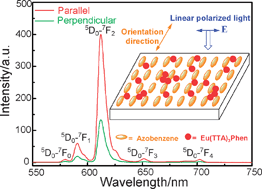Optically controllable polarized luminescence from azopolymer films doped with a lanthanide complex†
Abstract
Two azopolymers (DACENO2 and DACEOCH3) with a special structure were designed and synthesized. The azopolymer films doped with the lanthanide complex Eu(TTA)3Phen were prepared by a casting method with a mixed solution of the azopolymer and lanthanide complex.


 Please wait while we load your content...
Please wait while we load your content...